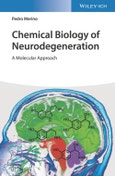Written by an experienced neurochemist, this book focuses on the main actors involved in neurodegenerative disorders at a molecular level, and places special emphasis on structural aspects and modes of action. Drawing on recent data on enzyme structure, mode of action, and inhibitor design, it describes?from a biochemical point of view?the six most important neurotransmitter systems and their constituent enzymes and receptors. Misfolding and aggregation of proteins within the brain is also covered. In addition, the book surveys a wide range of proven and prospective therapeutic agents that modulate key processes in the brain, from their chemical synthesis to their mode of action in model systems as well as in the patient.
Chemical Biology of Neurodegeneration: A Molecular Approach is presented in two parts. The first introduces the neurotransmitter systems and provides a general explanation of the synapse and a description of the main structures involved in neurotransmission that can be considered therapeutic targets for disorders of the central nervous system. The second part presents molecular and chemical aspects directly involved or affected in neurodegeneration, including the metabolism of neurotransmitters, enzymes processing neurotransmitters, protein misfolding, and therapeutic agents.
-Uses an interdisciplinary approach to bridge the gap between the basic biochemical events in a nerve cell and their neurological effects on the brain
-Places emphasis on the chemistry of small molecule modulators that are potential lead molecules for new drugs
-Covers six key neurotransmitter systems and their enzymes and receptors?dopaminergic, noradrenergic, serotonergic, cholinergic, GABAergic, and glutamatergic
Chemical Biology of Neurodegeneration: A Molecular Approach is a key resource for medicinal chemists, neurobiologists, neurochemists, biochemists, molecular biologists, and neurophysiologists.
Table of Contents
Preface xi
Part I Neurotransmitter Systems 1
1 The Dopaminergic System 3
1.1 Introduction 3
1.2 Dopamine Receptors 5
1.2.1 Classification 5
1.2.2 Location 5
1.2.3 General Structural Considerations 6
1.2.4 Effector Mechanisms 8
1.2.5 Implication in Neurodisorders 9
1.2.6 D1‐like Receptors 9
1.2.7 D2‐like Receptors 12
1.3 Vesicular Monoamine Transporter (VMAT) 18
1.4 The Dopamine Transporter (DAT) 21
1.4.1 Structural Aspects 21
1.4.2 Molecular Mechanism 24
References 26
2 The Noradrenergic System 41
2.1 Introduction 41
2.2 Adrenoreceptors 43
2.2.1 Classification 43
2.2.2 Location 44
2.2.3 General Structure Considerations 44
2.2.4 Effector Mechanisms 44
2.2.5 Implication in Neurodisorders 45
2.2.6 α1‐Adrenoreceptors 46
2.2.7 α2‐Adrenoreceptors 48
2.2.8 β‐Adrenoreceptors 49
2.3 Neuropeptides Receptors 58
2.3.1 Neuropeptide Y Receptors 58
2.3.2 Galanin Receptors 61
2.4 Norepinephrine Transporter (NET) 63
References 65
3 The Serotonergic System 81
3.1 Introduction 81
3.2 Serotonin Receptors 83
3.2.1 Classification 83
3.2.2 Location 86
3.2.3 General Structural Considerations 86
3.2.4 Effector Mechanism 87
3.2.5 Implication in Neurodisorders 88
3.2.6 5‐HT1 Receptors 89
3.2.7 5‐HT2 Receptors 92
3.2.8 5‐HT3 Receptors 96
3.2.9 5‐HT4 Receptors 98
3.2.10 5‐HT5 Receptors 98
3.2.11 5‐HT6 Receptors 100
3.2.12 5‐HT7 Receptors 101
3.3 Serotonin Reuptake Transporter (SERT) 102
References 107
4 The Cholinergic System 121
4.1 Introduction 121
4.2 Cholinergic Receptors 123
4.2.1 Classification 123
4.2.2 Location 124
4.2.3 Nicotinic Receptors 125
4.2.3.1 Effector Mechanisms 125
4.2.3.2 Implication in Neurodisorders 126
4.2.3.3 Structure of Subunits 126
4.2.3.4 Structure of Receptors 126
4.2.4 Muscarinic Receptors 132
4.2.4.1 Effector Mechanisms 133
4.2.4.2 Implication in Neurodisorders 134
4.2.4.3 M1 Receptor 134
4.2.4.4 M2 Receptor 135
4.2.4.5 M3 Receptor 135
4.2.4.6 M4 Receptor 139
4.2.4.7 M5 Receptor 141
4.3 Cholinergic Transporters 141
4.3.1 Vesicular Acetylcholine Transporter (VAChT) 141
4.3.2 High‐Affinity Choline Transporter (ChT) 143
References 145
5 The Glutamatergic System 155
5.1 Introduction 155
5.2 Glutamate Receptors 157
5.2.1 Classification 157
5.2.2 Ionotropic Receptors 159
5.2.2.1 Location 159
5.2.2.2 Effector Mechanisms 161
5.2.2.3 Implication in Neurodisorders 162
5.2.2.4 NMDA Receptors 162
5.2.2.5 AMPA Receptors 165
5.2.2.6 Kainate Receptors 168
5.2.2.7 Delta Receptors 172
5.2.3 Metabotropic Receptors 173
5.2.3.1 Location 173
5.2.3.2 Effector Mechanisms 174
5.2.3.3 Implication in Neurodisorders 175
5.2.3.4 Structural Features 176
5.3 Glutamate Transporters 184
5.3.1 Implication of Glutamate Transporters in Neurodegeneration 186
5.3.2 Vesicular Glutamate Transporter 1 (VGLUT1) 187
5.3.3 Vesicular Glutamate Transporter 2 (VGLUT2) 187
5.3.4 Vesicular Glutamate Transporter 3 (VGLUT3) 187
References 188
6 The GABAergic System 199
6.1 Introduction 199
6.2 GABA Receptors 201
6.2.1 Classification 201
6.2.2 Location 201
6.2.3 Implication in Neurodegenerative Disorders 204
6.2.4 GABAA Receptors 204
6.2.4.1 Effector Mechanisms 205
6.2.4.2 Structure of Subunits 206
6.2.5 GABAB Receptors 210
6.2.5.1 Effector Mechanisms 210
6.2.5.2 Structure of Receptors 212
6.3 GABA Transporters 213
6.3.1 Vesicular GABA Transporter (VGAT) 216
6.3.2 Betaine Transporter (BGT1) 216
6.3.3 Sodium‐ and Chloride‐Dependent GABA Transporters (GAT1-3) 216
References 218
Part II Metabolism and Proteins 227
7 Metabolism of Neurotransmitters 229
7.1 Introduction 229
7.2 Metabolism of Catecholamines 229
7.2.1 Dopamine 229
7.2.2 Norepinephrine (Noradrenaline) and Epinephrine (Adrenaline) 234
7.3 Metabolism of Serotonin 235
7.4 Metabolism of Acetylcholine 238
7.5 Metabolism of Glutamic Acid and GABA 239
7.5.1 Glutamic Acid 239
7.5.2 γ‐Aminobutyric Acid (GABA) 240
7.5.3 Neurotransmission Mediated by Glutamic Acid and GABA Metabolisms 240
References 242
8 Enzymes Processing Neurotransmitters 249
8.1 Tyrosine Hydroxylase (TH) 249
8.2 Tryptophan Hydroxylase (Tryptophan‐5‐monoxygenase, TPH)) 252
8.3 Aromatic Amino Acid Decarboxylase (AADC) 255
8.4 Dopamine β‐Hydroxylase (DBH) 257
8.5 Monoamine Oxidase (MAO) 259
8.6 Catecholamine‐O‐methyl Transferase (COMT) 265
8.7 Phenylethanolamine‐N‐methyl Transferase (PNMT) 270
8.8 5‐Hydroxyindole‐O‐methyltransferase (HIOMT) 272
8.9 Serotonin‐N‐acetyl Transferase (SNAT) 274
8.10 Choline Acetyltransferase (ChAT) 274
8.11 Acetylcholinesterase (AChE) 276
8.12 Glutamic Acid Decarboxylase (GAD) 280
8.13 Glutamine Synthetase (GLUL) 281
8.14 GABA Transaminase (GABA‐T) 284
References 286
9 Misfolded Proteins 303
9.1 Introduction 303
9.1.1 Amyloid β (Aβ) 304
9.1.2 Tau (τ) 307
9.1.3 α‐Synuclein 313
References 316
10 Therapeutic Agents for Neurodegenerative Disorders 325
10.1 Alzheimer’s Disease (AD) 325
10.1.1 Acetylcholinesterase (AChE) Inhibitors 325
10.1.2 Memantine (Namenda®) 331
10.2 Parkinson’s Disease (PD) 331
10.2.1 l‐DOPA 333
10.2.2 Dopaminergic Agonists 335
10.2.3 MAO‐B Inhibitors 340
10.2.4 COMT Inhibitors 343
10.2.5 Amantadine 344
10.3 Lewy Body Disease (LBD) 345
10.4 Huntington’s Disease (HD) 346
10.5 Friedreich’s Ataxia (FA) 346
10.6 Amyotrophic Lateral Sclerosis (ALS) 346
10.7 Spinal Muscular Atrophy (SMA) 347
References 347
Index 359








